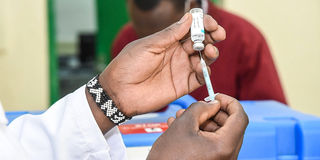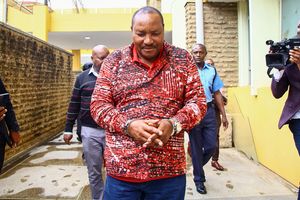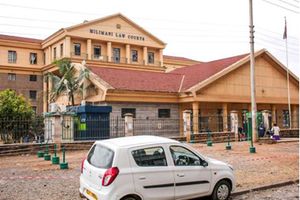How prepared is Kenya as GAVI plans exit?
Sponsored content

By Maureen Ongala and Wachira Mwangi
Kenya risks sinking into a health disaster if the government fails to allocate enough funding for immunisation before the exit of the Global Alliance for Vaccines and Immunisation (GAVI) by 2027. The is according to the Health Non-governmental Organisations Network (HENNET).
GAVI, the main donor for vaccines and immunisation programmes in the country, is set to exit the region.
In a recent interview with Daily Nation, HENNET policy engagement and advocacy manager, Ms Elizabeth Muchoki, said a majority of children from hard-to-reach areas and those in informal settlements in urban towns will be severely affected.
Ms Muchoki is of the view that while 80 percent of the children in the country get the required basic immunisation, the remaining 20 percent are still a big number. Yet despite the transition period issued by GAVI before it exists, the country, she says, is doing little to ensure the sustainability of immunisation programmes. “The risk is disastrous and we will be going back to the era of diseases,” she warns.
“We knew way back that GAVI gave a plan in 2015 on how we will fund immunisation and we have been talking about the issue since 2012. There were expectations that the government would come up with plans on how to take care of its children and the community,” she says, adding that it is expensive to vaccinate a child and that the whole process needs proper financial planning. In 2018-2019, HENNET established that it costs about Ksh3,500 to immunise a child per year.
Ms Muchoki says there are possibilities the demand for vaccines in the country will increase due to the rapid growth in population. “Many children are being born every day.... This will have a financial implication,” Ms Muchoki argues. HENNET is supporting county governments to come up with a costed implementation plan (CIP) to call for domestic funding.
Kilifi County Head of Family Health Services, Mrs Jesca Deche, is urging the National Government and county governments, and also relevant non-state actors, to allocate enough funds for immunisation programmes. “Many partners have interests in maternal programmes but not immunisation. The support for immunisation is low,” she says.
Mrs Deche notes that with the high poverty levels in Kilifi County, many families struggle to treat diseases. Therefore, the government should prioritise disease prevention.
Mrs Deche stresses that Kilifi County badly needs an immunisation exercise. As per 2020 data, some 22 percent of the children in the county had missed immunisation. Magarini and Rabai sub-counties showed the highest cases of children who had not been immunised, compared to Kilifi North Sub-County and the other four. Mrs Deche cites the vastness of the area, lack of enough health facilities, poor electricity coverage and limited road networks as the major challenges hampering immunisation in Magarini.
“Magarini Sub-County is like a half of Kilifi County. If we were to reach the furthest area in Bombi village, it requires a lot of resources, including very strong vehicles. There are 50 hospitals and not all are offering immunisation services,” she says. Lack of storage facilities has also contributed to poor uptake of vaccination.
“The gap is not good for the county. Of the 22 percent of children who have not been immunised in Kilifi, half of them are from Magarini. If we are to use solar power, then it must be reliable. We have old fridges that need to be replaced. Moving vaccines interferes with service delivery because of the wide area. Many mothers will not access the immunisation centres as they are far apart,” Mrs Deche explains.
“Outreach programmes would work better to reach communities in remote areas where the population is also scattered. This will work with proper planning and funding,” she argues.
County budget allocation to the health department, according to her, is a drop in the ocean. In each of the 2018/2019 and 2021/2022 financial years, immunisation programmes were allocated only Ksh1.2 million, she says.
“This money is not enough. We always don’t feel the weight when the donor is funding, but in immunisation, we are talking of billions of money,” says Mrs Deche, urging the county government to prioritise immunisation awareness and its importance to the public.
Kilifi County Executive Officer for Health, Mr Charles Dadu, calls for diversification in immunisation. He says this will help counties to address the challenges of storage, electricity and physical accessibility in remote areas.
The CEC says Kilifi County Government initiated a solar connectivity programme with the support of UNICEF to supply power in health facilities in Magarini Sub-County.
He adds that the county is set to enter into an agreement with Malindi Solar Company to roll out the solar power connections in remote areas of the county. “The sustainability in the journey of self-reliance calls for multi-stakeholder involvement. We need to have intergovernmental engagements to see how county governments can complement one another,” he adds.
SIDE BAR
Immunisation champion brings grassroots challenges to the table
Msumarini village in Kikambala location in Kilifi South sub-county is the home of an immunisation champion in the county. Mr Omar Bandika is among the voices that have been advocating for domestic budgeting for immunisation.
Bandika coordinates and works with other champions in seven sub-counties to ensure that the calls for immunisation financing is heard. He says they are now putting together a coalition to strengthen their voices.
“With all of us and even other stakeholders coming together, we will have an even stronger voice to ensure that counties are investing much in immunisation to guarantee routine vaccination and availability of other vaccines,” he says. So far, the coalition has about 13 members, he says, among them Kwetu Training Centre, Angaza Youth Initiative, Kaloleni Youth Empowerment Centre, Exodus CBO, DSW Kenya, Pathfinder Kilifi, Moving the Goalpost, and Youth for Sustainable Development, and more. “Together, we sit down and plan the push for more funding for immunisation,” Bandika says.
He is concerned that immunisation is least embraced by both national and county governments, making it look like a foreign agenda being pushed by non-governmental organisations and development partners.
“If you fetch water, you will be able to know to value it. The common mwananchi doesn’t understand what it costs to get the vaccines. We need political goodwill in immunisation. We need our politicians to bring this discussion so that we can prevent these diseases instead of waiting to cure them,” Bandika stresses.
He adds that as immunisation champions, they promote dialogue on the top. Together with partners, they conduct sensitisation and awareness programmes to enlighten the community about the importance of being vaccinated.
“We are speaking to the community to make them understand that vaccination or immunisation is a very cost-effective investment for public health. We also try to make them understand the importance of being vaccinated,” he says.
The team also engages policy-makers to appreciate the financing gaps in immunisation and why the counties need to prioritise budgeting for vaccines ahead of the scheduled exit of the Global Alliance for Vaccines and Immunisation (GAVI).
According to Mr Bandika, the challenges in enhancing immunisation vary. “There are those that come with access. At all times, we see women visiting facilities for routine vaccines, like polio, tetanus, and measles,” he says, adding that the major challenge is in the sustainability of the provision in terms of cold chains, so that the hard to reach areas are covered.
The champion gives the example of his local Msumarini dispensary, where there is a big challenge of unstable power supply.
“Some of the vaccines have to be moved from here to the Vipingo Health Centre. Thanks to the County Government and its partners, we managed to get a standby generator that solved the erratic power supply. This is only one of the many scenarios. There is a lack of facilities in some of the health centres,” he says.
He notes that the vaccines require to be kept in certain temperatures and some of the available refrigerators are old and lack spares. “A time like this, we need modern cold chain equipment to ensure the safety of the vaccines.”
However, Mr Bandika points out that with a community that has low health literacy, understanding Covid-19 and the vaccine has been a great challenge. “There were myths that emerged, especially with the HPV and the Covid-19 jabs. They say it is a way to regulate the fertility of African women and many have warned their girls against taking the jabs,” says Mr Bandika with concern.
As a champion, he has had to take the Covid-19 vaccine first to convince community members to also get the jabs.
He also observes that there is a need for men to actively take part in the immunisation narrative to enable uptake. “We want to ensure that the discussion on vaccination and immunisation leaves the boardrooms to the grassroots,” he stresses.


